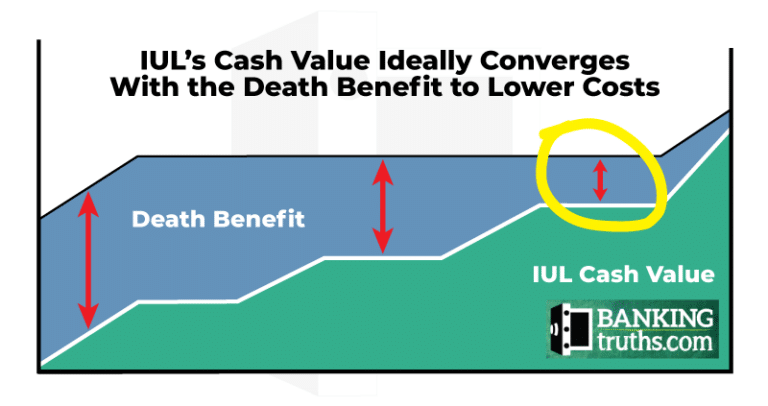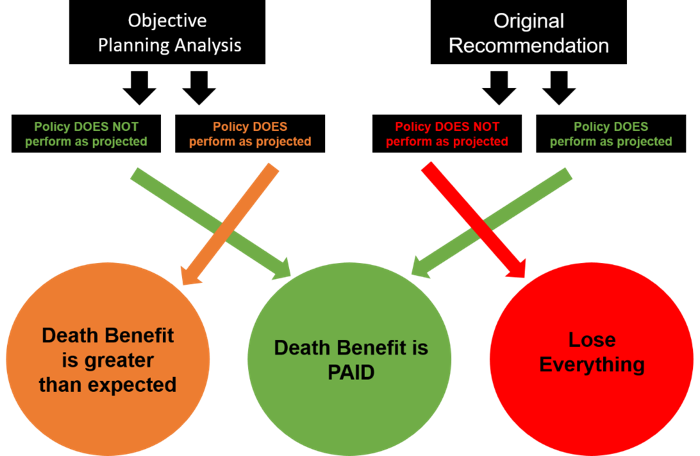All Categories
Featured
Table of Contents
For earning a limited quantity of the index's development, the IUL will never ever receive less than 0 percent passion. Even if the S&P 500 decreases 20 percent from one year to the next, your IUL will not shed any type of cash value as a result of the market's losses.

Talk regarding having your cake and eating it too! Envision the interest worsening on an item with that sort of power. Offered all of this info, isn't it conceivable that indexed universal life is an item that would permit Americans to purchase term and spend the rest? It would certainly be hard to argue against the logic, would not it? Now, don't obtain me wrong.
A real investment is a protections item that is subject to market losses. You are never based on market losses with IUL merely since you are never based on market gains either. With IUL, you are not purchased the marketplace, but just earning rate of interest based on the performance of the marketplace.
Returns can grow as long as you continue to make settlements or preserve a balance.
Universal Life Cash Surrender Value
Unlike universal life insurance coverage, indexed universal life insurance policy's cash value makes passion based on the efficiency of indexed supply markets and bonds, such as S&P and Nasdaq., mentions an indexed universal life policy is like an indexed annuity that feels like global life.

Because of these functions, irreversible life insurance policy can work as an investment and wealth-building device. Universal life insurance coverage was created in the 1980s when rates of interest were high. Like various other sorts of permanent life insurance policy, this plan has a cash value. Universal life's cash money worth earns passion based upon existing money market rates, but rates of interest fluctuate with the market.
Indexed universal life policies use a minimum surefire rate of interest price, additionally understood as an interest attributing floor, which minimizes market losses. Say your cash value sheds 8%.
Fixed Universal Life
It's also best for those going to think extra threat for greater returns. A IUL is a permanent life insurance coverage policy that obtains from the properties of an universal life insurance policy plan. Like universal life, it allows flexibility in your fatality advantage and premium repayments. Unlike global life, your cash worth grows based on the efficiency of market indexes such as the S&P 500 or Nasdaq.
Her job has been published in AARP, CNN Emphasized, Forbes, Lot Of Money, PolicyGenius, and United State News & World Report. ExperienceAlani has reviewed life insurance policy and family pet insurance policy companies and has created numerous explainers on travel insurance, credit history, debt, and home insurance. She is passionate concerning demystifying the intricacies of insurance coverage and various other personal financing subjects to make sure that viewers have the information they need to make the most effective money decisions.
:max_bytes(150000):strip_icc()/dotdash-comparing-iul-insurance-iras-and-401ks-Final-71f14693e37d4fb1b0736112179802b5.jpg)
Paying only the Age 90 No-Lapse Premiums will guarantee the survivor benefit to the insured's attained age 90 yet will not guarantee cash money value accumulation. If your customer terminates paying the no-lapse assurance premiums, the no-lapse function will certainly end before the assured duration. If this happens, added costs in an amount equivalent to the deficiency can be paid to bring the no-lapse function back active.
I recently had a life insurance policy sales person appear in the remarks thread of an article I published years ago concerning not blending insurance coverage and investing. He believed Indexed Universal Life Insurance Coverage (IUL) was the very best point since sliced bread. In support of his setting, he posted a web link to a write-up composed in 2012 by Insurance Policy Representative Allen Koreis in 2012, qualified "16 Reasons Accountants Prefer Indexed Universal Life Insurance Policy" [web link no longer readily available]
Universal Life Insurance Calculator Cash Value
First a quick explanation of Indexed Universal Life Insurance Policy. The tourist attraction of IUL is evident.

If the market decreases, you obtain the guaranteed return, generally something in between 0 and 3%. Obviously, because it's an insurance plan, there are likewise the common prices of insurance policy, compensations, and abandonment costs to pay. The information, and the reasons that returns are so horrible when mixing insurance coverage and investing in this particular way, boil down to basically 3 things: They just pay you for the return of the index, and not the returns.
What Is Group Universal Life
If you cap is 10%, and the return of the S&P 500 index fund is 30% (like last year), you get 10%, not 30%. If the Index Fund goes up 12%, and 2% of that is returns, the adjustment in the index is 10%.
Include all these impacts together, and you'll find that long-term returns on index universal life are rather darn near to those for whole life insurance policy, favorable, however low. Yes, these policies guarantee that the money value (not the cash that goes to the costs of insurance, of training course) will certainly not shed cash, but there is no assurance it will maintain up with rising cost of living, a lot less grow at the price you need it to grow at in order to offer your retired life.
Koreis's 16 reasons: An indexed universal life plan account value can never ever shed cash due to a down market. Indexed global life insurance assurances your account worth, locking in gains from each year, called a yearly reset.
IUL account worths grow tax-deferred like a qualified strategy (Individual retirement account and 401(k)); shared funds do not unless they are held within a qualified strategy. Just put, this indicates that your account value advantages from three-way compounding: You make rate of interest on your principal, you earn rate of interest on your passion and you gain interest on the money you would certainly otherwise have actually paid in taxes on the passion.
Indexed Universal Life Insurance Definition
Although qualified plans are a better selection than non-qualified strategies, they still have problems not provide with an IUL. Financial investment options are normally limited to shared funds where your account value undergoes wild volatility from exposure to market threat. There is a big distinction in between a tax-deferred retired life account and an IUL, yet Mr.
You buy one with pre-tax dollars, saving on this year's tax obligation costs at your low tax obligation rate (and will often have the ability to withdraw your cash at a reduced efficient rate later) while you invest in the other with after-tax dollars and will certainly be required to pay rate of interest to borrow your very own money if you do not wish to give up the policy.
He throws in the traditional IUL salesman scare method of "wild volatility." If you hate volatility, there are much better methods to decrease it than by purchasing an IUL, like diversity, bonds or low-beta supplies. There are no limitations on the quantity that might be added annually to an IUL.

That's assuring. Allow's consider this momentarily. Why would the federal government placed limits on just how much you can take into retired life accounts? Perhaps, simply perhaps, it's because they're such a lot that the federal government doesn't want you to save as well much on taxes. Nah, that could not be it.
Latest Posts
Equity Indexed Insurance
Best Variable Universal Life Insurance Policy
Index Life Insurance Companies